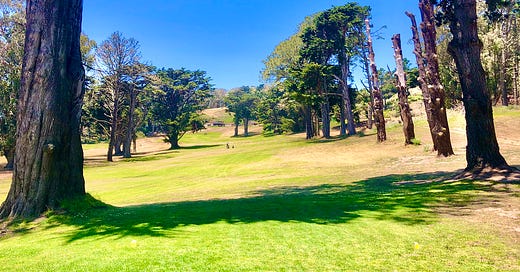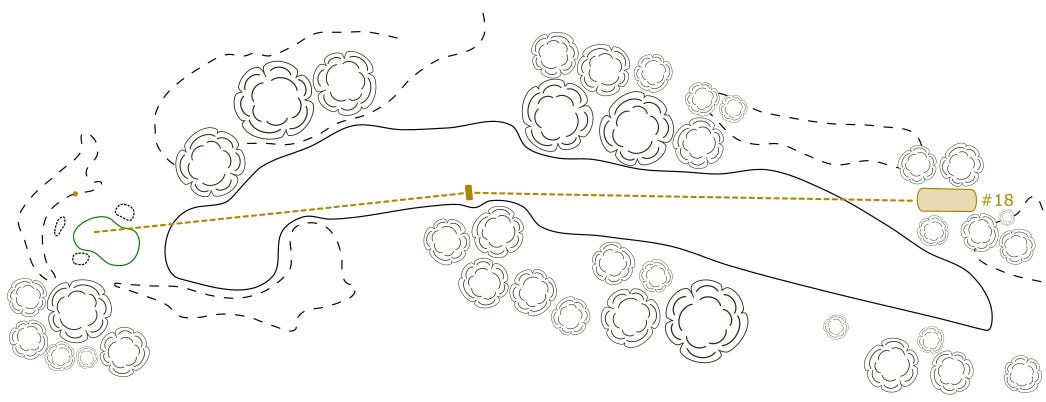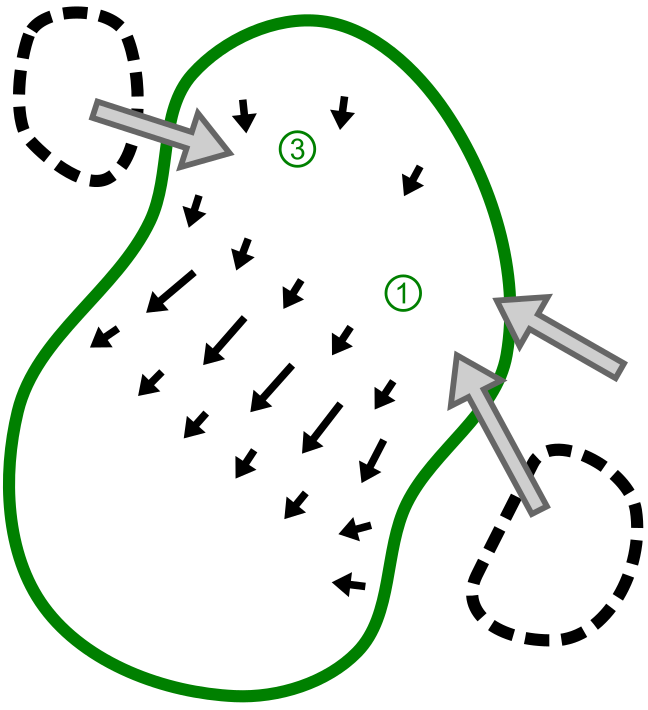Gleneagles GC at McLaren Park #9 & #18
Contours Forever: the return to the clubhouse at Gleneagles will force uneven, long, and risky shots.
This post is part of a series.1
Hole 9: par 5, 443 yards.
Hole 18: par 4, 343 yards.
#9: Where the Contours Work With You
The par five ninth is a real test. However, if each shot is executed properly, the flat lies and reasonable distances can make the hole very accessible. Play anything even slightly off target though, and the difficulty increases as the slopes and contours ask players to improvise.
Off the tee:
The tee shot plays over a sandy gap to a landing zone that is mostly flat on the left, and starts to curve up on the right side.
While it looks like the right side is a safe bailout, the right-to-left lie players end up with will add significant risk to their second shot. Playing the tee shot center-left near the trees leaves most with a perfect lie, but will mean drawing their second around those trees. End up too far left, and it may mean playing through the narrow gap in the trees.
Second:
The second shot must get past the dogleg to have a chance at the green. The whole fairway flattens about 100 yards from the green, so getting safely up to this landing zone will dramatically improve the chance of par. Be wary of playing too far right, however, as the two trees short of the green can block players out. As obvious as these “safe” areas seem, there is always danger lurking for those who play this hole without thinking.
A bad drive played too far left can put players in a section of trees called the Clown’s Mouth. This tunnel between the trees is surprisingly playable, and a well executed stinger can still leave a good chance at par.
Approach:
The approach is way uphill, and often into the wind. Give yourself a wedge in and you may have a decent chance at birdie. There is no playing to the center of this green. It has two tiers and you want to end up on the correct one. Players with an uneven lie, or those who are blocked, might want to think hard about laying up. The real danger is not the bunkers, but the left miss. If you can keep the ball right of the green, you’ll always have a chance, but miss left, and you’ll be looking at a shot (or two) just to get back up to the tier that the hole sits on.
Once on the green though, players will have to deal with the biggest contour on the course.
#18: Where the Contours Work Against You
The par four 18th hole is a much tougher variant of the ninth hole. To start, the tee shot gives an awkward angle to the fairway. Worse yet, the tee box tilts left, leaving a tough standard pull unless players are able to compensate. The hole should be easier than the ninth, but there is less room for error, especially on the approach.
The tee shot plays to a narrow gap in the trees, typically into a strong prevailing headwind. The standard miss is a ballooning shot, pushed right in the headwind. The best-case scenario when this happens is that the ball kicks left, back down the fairway. The worst-case scenario is getting caught up in the trees on the right.
The risk-reward line for most players is to play toward the big tree left. A miss here will send the ball into the scruff down the hill, with potential to be blocked out, but getting the ball just right of the tree will leave a perfectly flat lie and a clear shot to the green.
One of my favorite shots on the course is a tee shot strategy to take much of the headwind out of play.
The approach can be similar to the ninth hole if the tee shot is perfect, but it’s typically longer and more challenging. Laying up is often a good idea simply because missing the elevated green is so dangerous.
The Green: No Way Down
Tier is everything:
The green on this hole is an absolute monster. The massive contour between the tiers is challenging for people to putt up, and nearly impossible to putt down. The most dangerous miss here, however, is missing left (even running off the green left). Anything left can end up rolling down the hill, and could end up being anything from a short chip to a healthy pitch away from the green. This can be especially troublesome when the hole location is on the upper tier.
The upper tier
The upper tier is probably more challenging to reach, but it’s easier to recover from a bad shot. There is a decent amount of bailout to the short-right side, and even ending up in a bunker isn’t a terrible spot considering how bad a miss can end up here.
Don’t get greedy on these pin positions. Missing short will roll you down off the green. Missing long will leave an incredibly testing chip shot. You may never really understand how scary this green can be until you have a downhill putt that runs straight at the edge of the contour.
The lower tier
The lower tier is less scary on the putting surface, but can still be tricky on the approach. You can use the huge contour to your advantage. A shot that runs up the right side can roll back to the more dangerous position on the left.
Playing straight at the hole risks running down the hill left.
Getting down means skill and luck
Finding yourself on the top deck when the hole is below you is a nightmare. Getting down off the upper tier while holding the green is nearly impossible. Even a ball that is placed on the ridge will run off.
Still, there is a method to at least get the ball close. The contour is the smallest on the right side, and players can run the ball right, to get as much friction as possible (even rubbing up against the fringe), to keep the ball from running off. The only other option is to aim for the flag stick and try to get lucky.
The Peanut Gallery
Whether or not this green is “fair” is of no concern to the regulars. If you find yourself in a bad spot, it’s your own fault. Tactics and strategy are key to getting the ball down in two putts, and they’ll let you know when you’ve made good choices. It’s not uncommon to find a few locals above the green, sipping their drinks and watching folks play in. There are cheers for good shots and jeers for bad judgment. They’ll let you know, but it’s all in good fun.
History
The hole looks nearly identical to what it looked like when it was built, but without the three greenside bunkers. However, it also appears that the green used to extend further right than it currently does. This larger green would be much more receptive to long shots, especially if the contour was more gentle on the right side. If the fairway was kept short around the edges, it may have been a half punchbowl green.
Thoughts
Both nine and eighteen are exceptional holes in the level of challenge and strategy they offer players. At nearly every point on both holes there is significant risk to being out of position, there are options for recovery, and there are benefits to laying up. This type of optionality is a hallmark of interesting golf, however, on a finishing hole, I see it as beneficial that the optionality is less about options in shot preferences and more about mitigating damage.2
The ninth hole, as a par five, definitely provides a less stressful introduction to the hole. The 18th hole, as a challenging par four, provides the type of high variance that people expect from a stroke play tournament finisher. A putt on the green that can inflict much more damage than a poor tee shot. Unlike the par five version, every shot must be perfect to get through this hole stress free, and recovery shots on the 18th will be dramatic for stroke play.34
An obvious place for improvement, though, is the tee boxes. The tilt on the 18th tee is infuriating, and makes a challenging tee shot nearly impossible. While the architecture on this hole is impeccable, the inability for folks to hit an ideal tee shot seems to undermine the hole significantly. The uphill layout on the ninth can be frustrating as well, but less so. Dramatically uneven tees are an issue across the course, but the only place they affect play more than the 18th is on the 3rd/12th hole.
Finally I want to reiterate the benefits of having a culture of community around the finishing hole. While this might not be good for every course, as many may desire more of a refuge, I think it’s safe to say that urban, public courses would all benefit from a community-oriented 18th green. I’ve written about the benefits to public courses gained by leveraging their amenities to the non-golfing public, and how fostering a sense of community is important to creating a sustainable player base for the game.5 I think making the 18th green a point of social interaction both keeps people at the golf club after their round, and provides plenty of opportunities for discussion.
Seeing the audience above the 18th roar with approval as an approach shot lands within six feet makes this benefit obvious. The course is not just a center for recreation, but a source of entertainment as well. While I’ve seen courses that put the final green within view of the restaurant or bar, few actually allow for interaction. The way this green interacts with the clubhouse shows how architectural design can work to change the experience of the course. Leaving the course here isn’t just going to your car; it often involves someone asking how your round went or having a drink with friends overlooking the last hole yourself
Other posts in this series:
#1 & #10: A deep dive into the architecture that makes this intimidating opening hole so interesting.
#2 & #11: A Switch From Strategic to Penal Architecture
#3 & #12: Down the Hill
#4 & #13: Visible and Invisible
#5 & #14: Short and Long
#6 & #15: The Old Road
#7 & #16: Wind Tunnel and Blind Bunkers
#8 & #17: Invisible Redan
#9 & #18: Contours Forever
#19: Old Peculiar’s
Here I think it’s worth entertaining some ideas on the differences in optionality in golf. I think my favorite type of optionality is that of various shot options to the same landing zone (typically a green). This was especially illustrated on hole seven where folks out of position can use the right-side slope to kick balls onto the green.
The type of optionality here is different. It’s effectively a type of route-to-green optionality, or risk-mitigation optionality. For example, look at the Clown’s Mouth as a recovery route. Instead of forcing a half-stroke loss, it offers a choice between taking that half-stroke by pitching into the fairway, but it also offers a low probability option if players believe they can execute two challenging shots: the punch through the gap in the trees, followed by an approach shot with at least 15 feet more elevation change. This is a type of strategic optionality that offers different risk profiles and is likely more relevant in games that limit downside risk, like match play.
This optionality is especially relevant on the 18th hole because of the highly penal nature of the approach shot. A missed approach can easily cost a player two strokes. Even missing the correct tier can cost the player a stroke. Importantly, the bailout to the right side of the green is effectively inaccessible if they player missed right off the tee, so laying up for bogey can easily be the best play, even if there is a plausible shot to the green. These are tough choices for the player, but interesting architecture is based on giving the player relevant choices.
The most dramatic of these recovery shots is the ball-above-feet fade from the right side miss off the tee. The real damage from of missing right off the tee is that it forces this as the only available approach to the green. The danger here, that the ball does not cut enough, brings some of the worst consequences on the hole, missing the green left, and tumbling down the hill toward the 5th/14th green. Even a slight miss on this shot can give a much more punishing shot than a layup. Making the safe approach bailout inaccessible to the safe tee shot bailout is a masterstroke in finishing hole architecture.
It should also be noted here that, while the club does play stroke play in most of their tournaments, the club’s regular game is a rabbit. There are some serious issues with having such a challenging finishing hole in a match play game format.
Firstly, the index is very high for a rabbit closer, which makes players feel like it’s not an exciting finish, as someone will undoubtedly get a net birdie, if they have a couple strokes. Again, the hole is a relatively easy bogey, so a bogey golfer with two strokes has a trivial birdie opportunity. There isn’t an easy way to decrease the hole’s index without dramatically changing the hole, or perhaps removing the bunkers, which honestly serve little function beyond adding more ruthlessly penal aspects to the hole.
A club playing a rabbit as their main game ought to have their highest few index holes elsewhere. Match play advocates generally suggest that the 17th hole be the highest index, and a rabbit would be well served by a high index on holes eight and 17, with a low index (and arguably reachable) ninth and 18th holes (both finishing holes in a rabbit). This allows players to acquire a leg on the eighth or 17th by besting the competition, and to keep it on the next hole by getting the easy birdie.


















